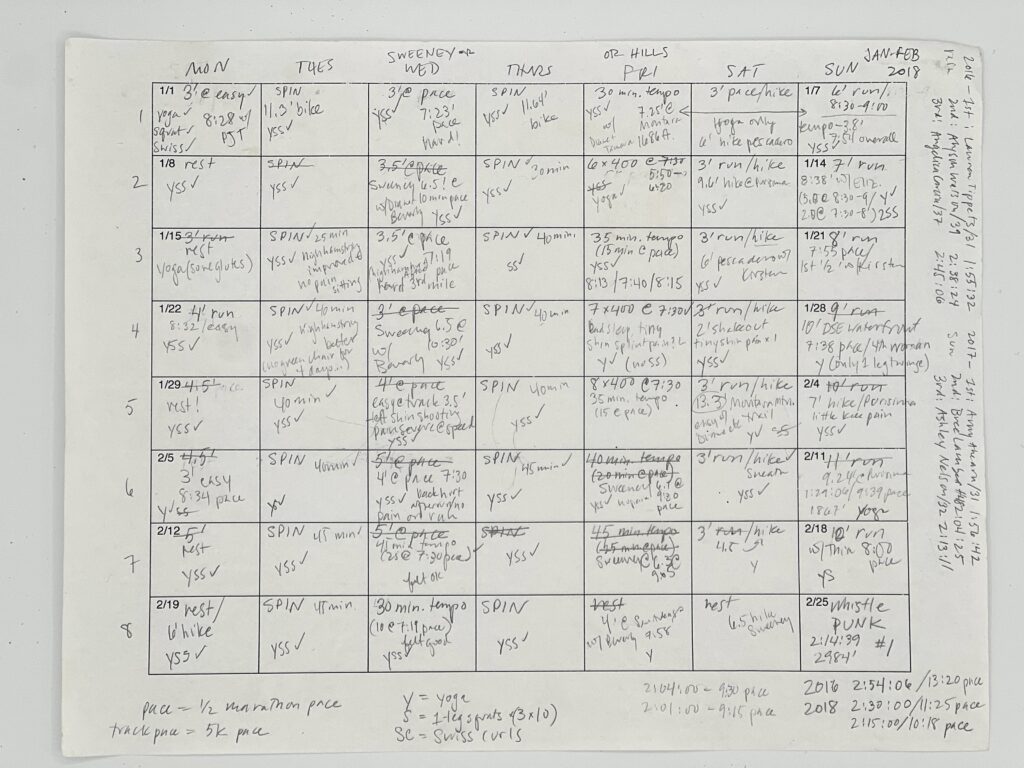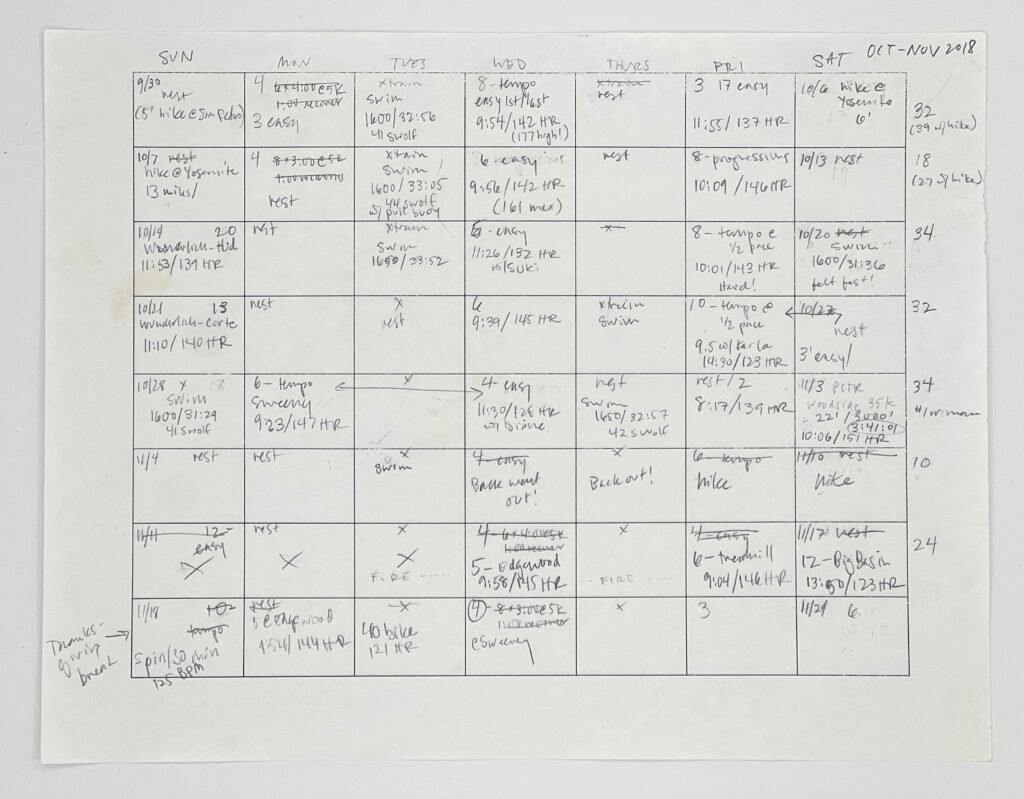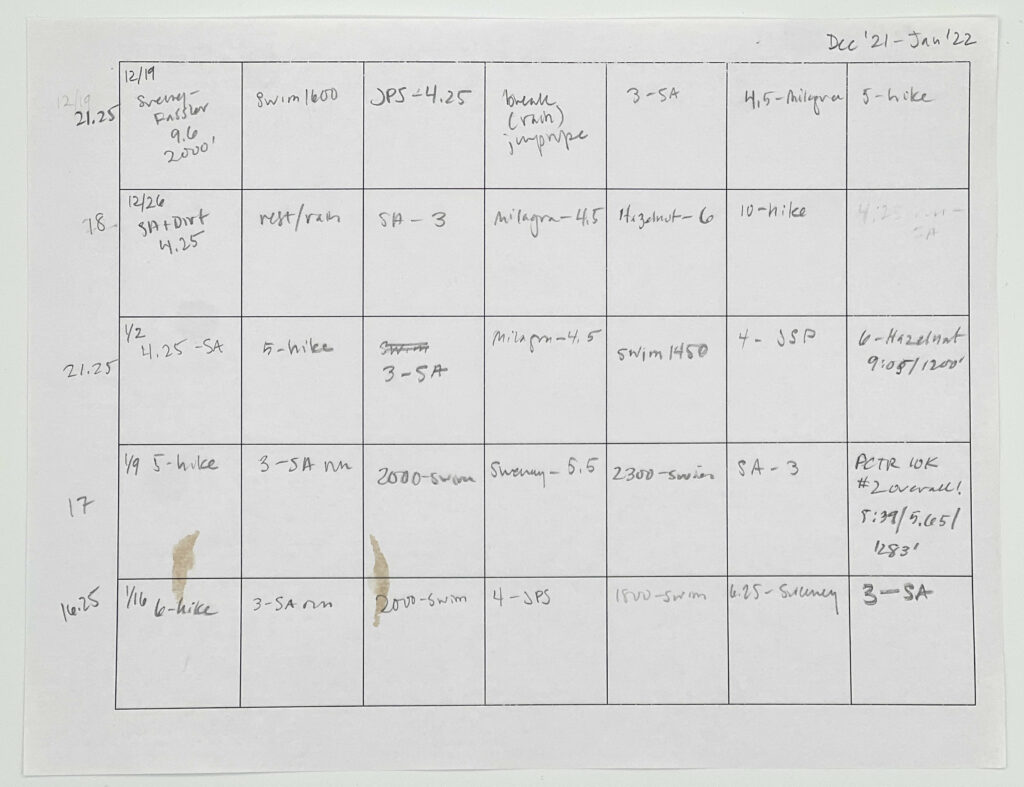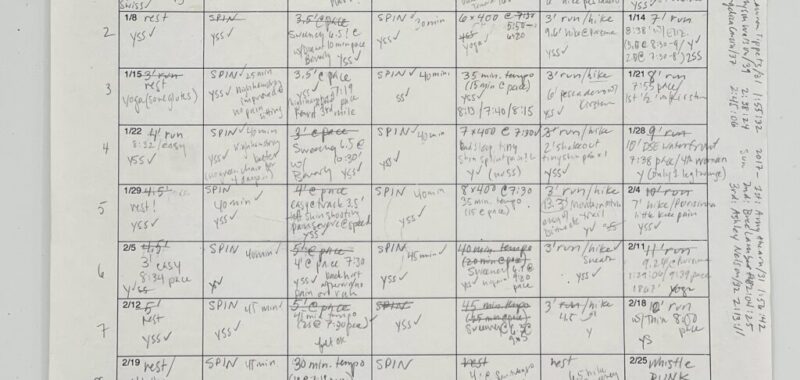
Photograph courtesy of Kim Beil.
My running diary is a stack of 8 ½ x 11” papers printed with a calendar grid. The small boxes demand brevity. Cryptic penciled notes represent dates, times, distances, elevations, routes, and sometimes strangers’ names and course records. There are codes for heart rate (HR), physical-therapy exercises (yoga and single-leg squat: YSS), and personal records (PR). There’s space for an occasional comment: “Hard!” or “OK!” I would schedule my workouts weeks in advance, only infrequently crossing them out and altering the plan.
I created this calendar when I started running, and kept it through my late thirties. After a few months of exhausted frustration, I learned that I was anemic and probably had been for years. As supplements pumped iron into my blood, I found that I could run faster and farther. I felt like I was getting younger; it was like alchemy. The calendar helped me look forward to my fortieth birthday, a milestone I’d been taught to fear. The data prove that I love going over hills.
A few months into 2020, half a year after my birthday, the diary changes. In place of record times and podium finishes, there are notes about pain, walks, pills. I stopped labeling the years. But somehow the diary kept going, even when I had to stop running. These excerpts map my route through pain. Initially, I liked that the codes made the diary look like a scientific dataset. Keeping track of the numbers seemed like an objective measurement of myself, a way to gain a little distance from what it feels like to run—and to be unable to run. Later, I stopped keeping the diary, in order to collapse that distance again.
January–February 2018
January 1
3 miles easy; 8:28 pace
Not a New Year’s resolution, but a training plan. Working backward from a trail race, I blocked out a fifty-six-day month, irregular as a Roman January.
January 3
3 miles @ race pace; 7:23 pace (hard!)
This wasn’t the first time I’d trained for a race, but it was the first time I thought about more than finishing. I thought about winning.
January 5
7.25 miles @ Montara Mountain, 1,686’ elevation
This was the day before my thirty-eighth birthday, but I didn’t mark that on the calendar. It felt like a bad omen. My fear of aging had started in middle school. I was Peter Pan-sad when I was told that my body would change. Before my dad’s fortieth birthday his doctor told him to quit running: “If it hurts, don’t do it.” At my first job after college, a coworker watched me eat a maple doughnut and chided, “You won’t be able to do that when you turn thirty.”
January 22
4 miles easy; 8:32 pace
January 23
Cross-train; spinning 40 min.
high hamstring better
(no green chair for 4 days)
My writing chair: friend or foe? Usually I think that running helps my writing, but now it hurt to sit. I blamed it on the chair.
January 26
7 x 400 meters @ 7:30 pace
Bad sleep, tiny shin splints
Yoga (no single-leg squats)
January 28
Waterfront race
10 miles @ 7:38 pace, 4th woman
A warm-up race on hard, flat pavement along San Francisco Bay. Not at all like the trail race, except that I was nervous the night before and I was nervous at the starting line. I gave myself the night off from physical-therapy exercises.
February 21
30 min. tempo; 10 min @ 7:19 pace
felt good
February 25
Whistle Punk Half Marathon
13.1 miles; 10:18 pace / 2:14:39, 2984’ elevation
#1 woman
There’s little fanfare in this box, except the #1 and the story the numbers tell: There’s my 2016 time on the same course (2:54:06), my goal time (2:30:00), and my stretch goal (2:15:00, which was always my actual goal). I passed a man on the first climb who said something stupid and predictable about getting beaten by a girl. I ran faster after this. I got home and printed out another fifty-six-day calendar. I didn’t have much time left, I thought, before I got old and soft and slow.
October–November 2018

Photograph by Kim Beil.
October 14
Wunderlich Park, 20 miles
11:53 pace / 139 HR
I was running farther now, training for the Vista Verde Trail Marathon. It took a long time for me to run twenty miles in the mountains, but all the while I was entranced by the sunlight and fog in the redwoods and the feeling that, as Haruki Murakami wrote in What I Talk About When I Talk About Running, “there were still some possibilities left for me and my body.”
October 16
cross-train, swim
October 19
8 miles tempo @ race pace
10:01 pace / 143 HR
Hard!
November 3
Woodside 35K Race
22 miles / 3000’ elevation
3:41:01
10:06 / 151 HR
#1 woman
November 7
4 miles – easy
Back out!
I don’t know what having your back “go out” really means, but that’s what I say because it makes others understand the invisible pain. I lay flat on the floor and stared at the ceiling.
January 2020–January 2022

Photograph by Kim Beil.
January 2
Bike 12
Massage
At the end of 2018, my back had gotten better. I placed third woman in the Vista Verde Trail marathon, then I raced a 50K. But I tore a muscle in my quad on a muddy downhill during the race, and weeks in the calendar went blank. I came back, then got injured again later in the year. In 2020, the start of a new decade, I got myself a sports massage as an early birthday present. I was trying to stretch and fold my body back into a shape I recognized.
January 6
Swim
My fortieth birthday passed. No comment in the calendar.
January 8
2 @ Junipero Serra Park
10:15 pace / 147 HR
TRAIL!!
Slower than usual, but my all-caps exclamation and my heart-rate monitor seem to have recorded the effort and excitement of being back on the dirt, even if for only two miles.
February 1
8.5 @ Wunderlich Park
12:07 pace / 128 HR
New Nikes, no foot pain
The trail through the redwoods was soft and finally, instead of pain, I felt powerful on the long climb. I let myself rejoice in the fact that I’d moved up an age group.
February 22
Mt. Umunhum 14K
9:11 / 159 HR
#3 age group / 9th woman overall
I joined a running club and signed up for a team race. Against former college athletes, I felt like the amateur I was. The trail around an abandoned quicksilver mine was steep, loose, and rocky. Here I couldn’t win outright, except against myself. It was a personal record for this distance on a trail with almost two thousand feet of elevation gain.
February 26
6.8 @ Sweeney Ridge
9:50 / 148 HR
On my favorite trail, I ran into a friend of a friend. He was faster than me, but I stretched out my strides, trying not to lose speed on the downhills, though I’m usually cautious. We could see the airport, where midmorning long-haul flights from Asia were landing as usual. The novel coronavirus was in the news.
March 13
X
last day on campus
I drew an X through this day and the next; I didn’t have time to run. The university moved classes online due to COVID-19, and I had to attend meetings in which administrators advised us on how to transform our teaching for Zoom. “Sit in front of a clean background in a well-lit space” and “wear a plain, unpatterned top,” they said.
April 3
3 @ Junipero Serra Park closed, on road
9:26 / 144 HR
Local parks are closed.
May 5
13.6 @ Wunderlich Park
10:48 / 152 HR
I ran hard in the morning, then sat for hours in front of my clean background.
May 23
Swim
Back weird
July 5
4 @ San Andreas Trail
Shooting, electric pain down left leg while lying down
July 6
Swim
No sleep, leg pain
I was ejected from my chair by sudden pain. I grabbed my leg with both hands and walked in furious, frightened circles, trying to shake it off.
July 7
Express care
Slept with codeine
Piriformis syndrome?
Over Zoom, my doctor guessed that the pain was the result of my glutes impinging a nerve. (Should’ve done my physical therapy, I thought.) She told me to wait and see, and to stop running. It wasn’t life-and-death.
August 19
Bike 30 min.
FIRES
Dr. Levin!
The pain continued. I was awake all night. All day I paced indoors because there was wildfire smoke outside. Finally, the spinal specialist ordered an MRI and saw a herniated disc rubbing my sciatic nerve. I learned that the spinal column can be compressed by long hours of sitting. A Zoom injury.
September 6
Sweeney Ridge
5.5 mile hike
Bad pain @ p.m.
Codeine didn’t help
Two days after an epidural steroid injection and the pain was worse than ever. I’d started scrawling ugly notes about sleep and pills, so many pills, on the lines between each calendar day. I was still on a waiting list to see a physical therapist.
December 7
2 miles
5.5 miles
2 miles
1 mile
I started tallying my daily walks instead of runs. Only being in smooth, slow motion soothed the pain. I tried putting a treadmill under my standing desk, but walking on it nauseated me. Every morning, between classes, after lunch and dinner, and then again before bed, I took myself out for a walk. I was offered medical leave, but it would mean I’d lose my health insurance, and I’d finally gotten into physical therapy.
January 6
2
5.5
3
Bad sleep
It was my birthday. I wondered how much longer I could live like this. I was crying all the time.
January 25
3
2
2
Bad sleep
I was prescribed sleeping pills, but for months the calendar recorded “bad sleep.”
March 15
2
Swim
2
Good sleep
4 gabapentin
I got a COVID vaccine on March 5. Relief ran through me. At the physical therapist’s recommendation, I started listening to a podcast about pain science. Pain, the researchers said, is the body’s interpretation of sensation. Fear and anxiety amplify pain. Was it possible that my fears of COVID and chronic pain were creating more pain, even after my injury had healed? Understanding this helped me sleep. I could recover. I tapered the meds, like tapering workouts before a race.
March 31
2
5.5
1mile – run! (mtn. lion)
Good sleep
On a walk after dinner, I saw what I thought was a stray dog crossing the street in front of me. I put out my hand as it breathed by just six feet away. Its heavy tail nearly swept the ground. My body gathered itself into thought: mountain lion! This was no hypothetical lion, like the ones researchers use to explain the evolution of our human stress response. Unlike job stress and COVID fears, I could either fight or flee this lion. I backed away slowly, then jogged the mile home down the middle of the street.
April 13
1-run
3-walk
3-walk
Good sleep
I started running one mile per day, then more. I ran all summer. I raced again and came in second overall, beating all the men. I moved up another age group. I left the calendar behind.
Kim Beil is an art historian who teaches at Stanford.

